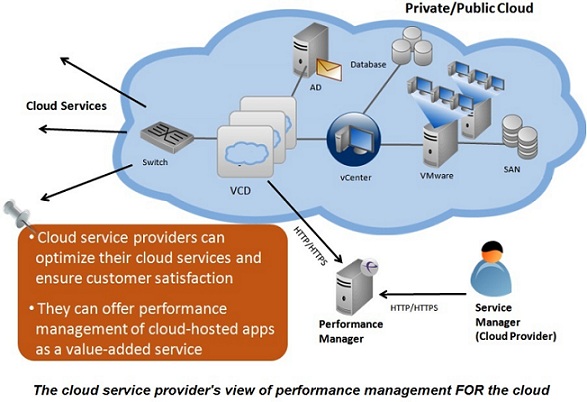
In my previous blogs in this four-part blog series I discussed performance management from the deployment perspective and the Cloud consumer view. The third perspective is that of the provider of the cloud service – whether it is the public cloud provider or the private cloud provider.
Start with Part One: Performance Management Challenges for Cloud-Hosted Services
Start with Part Two: Performance Management from the Cloud: The Deployment Perspective
Start with Part Three: Performance Management of the Cloud: The Cloud Consumer View
If you are the IT manager of a cloud service provider, the cloud itself is a service that that you are delivering to users. Your primary concern is to make sure that users of the cloud service are happy. Cloud service users must be able to login at any time, provision new instances as required, be able to start and stop instances and deploy applications in these instances.
For applications deployed in your cloud infrastructure, the performance of these applications should match the performance they would have had if they had been hosted on-premise, on physical machines.
Performance management FOR the cloud helps you, the cloud provider, deliver better cloud performance, maximum service availability, and superior customer satisfaction. The performance management system also helps you right-size your infrastructure, so that you can achieve the necessary returns for your investment in the cloud infrastructure.
To manage your cloud infrastructure, look for a performance management solution with the following characteristics:
Monitors the cloud infrastructure end-to-end
Typically, cloud infrastructures are built on a virtualization platform (e.g., VMware vSphere, Citrix XenServer, Microsoft Hyper-V). There are specialized applications that handle security (e.g., VMware vShield), web applications that enable user self-service and the cloud platform (e.g., VMware vCloud, Citrix CloudStack) that powers your cloud service.
The underlying infrastructure components including Active Directory, SAN, network equipment, etc. also need to be monitored as a failure of any of these components can also impact the cloud service. A performance management solution for the cloud should be capable of handling all of these infrastructure tiers from a central console.
Scalability
Scalability, to ensure that the management solution can handle the workload as your infrastructure grows, is another key requirement.
Supports Automation
A key driving factor for cloud computing is agility – the ability to power-up and power-down instances rapidly, on-demand. To achieve the kind of agility that customers expect, cloud service providers must make their operations fully automated. This covers the management system as well.
When a new cloud instance is provisioned, it should be automatically added to the management system for monitoring. Agent-based or agentless monitoring should be enabled. If required, agents should be installed on the cloud instances automatically. Touch-free provisioning and configuration of the management system is a very key requirement. Likewise, once provisioning and configuration of the monitoring has been done, alerts generated from the management system should be automatically handled.
To support this level of automation, the management system should support open interfaces that can be integrated with toolsets already being used by the cloud service provider. For instance, cloud service providers are already using runbook automation tools like Dynamic Ops, HP Orchestration and others. The performance management system should offer APIs (application programming interfaces) or CLIs (Command Line Interfaces) to allow its integration with the existing automation/orchestration tools.
For alert management, service providers often use trouble ticketing systems such as HEAT, BMC Remedy, and others. The management system must support interfaces that allow trouble tickets to be automatically opened when a problem is detected and automatically closed when a problem is fixed.

Allows cloud service providers to offer monitoring
The right performance management system will not only allow you to oversee the operation of your cloud service, but it can also allow you - the cloud service provider - to offer monitoring as a value-added service to your customers. For this purpose, the management system should support multi-tenancy – i.e., the same management platform can be used to monitor networks, servers and applications for multiple enterprise customers.
In this case, each customer gets a personalized login and when he/she logs into the management system, they only get to see the parts of the infrastructure that they have been configured to access and get reports for. The monitoring service can offer monitoring of the cloud instances that the customer is using. Advanced monitoring can also be offered to customers, providing them in-depth insight into applications like databases, web servers, Java applications, etc. that customers are hosting in the cloud.

The key benefits to service providers from a management solution that monitors the cloud infrastructure are:
- Ensuring that the performance of the cloud infrastructure meets the expectation of users.
- Facilitates effective provisioning of the cloud infrastructure to deliver the expected ROI without compromising on performance.
- Enables the cloud service provider to provide performance metrics of the cloud as a value-added service to their customers.
In summary, cloud performance management needs to be considered from three different perspectives, each of which has unique needs. A comprehensive approach needs to incorporate performance management FROM the cloud, OF the cloud and FOR the cloud. This will provide IT operations management with a new best practice for cloud performance management via a much more holistic view into every tier of the cloud infrastructure than traditional silo-based approaches provide.
This blog is the final in a series of four on cloud management.
Part One: Performance Management Challenges for Cloud-Hosted Services
Part Two: Performance Management from the Cloud: The Deployment Perspective
Part Three: Performance Management of the Cloud: The Cloud Consumer View
Srinivas Ramanathan is CEO and Founder of eG Innovations.

